This page describes installation of a Shindengen SH847 series regulator/rectifier (R/R) on a 1997 Honda Pacific Coast (PC800). Results of various tests performed after installation are included.
Editor’s Note: The following information comes entirely from fellow PCer Seth. He did excellent research and produced a wonderful writeup of how to install a series regulator rectifier (R/R) on a Honda Pacific Coast.
Introduction
This page describes installation of a Shindengen SH847 series regulator/rectifier (R/R) on a 1997 Honda Pacific Coast (PC800). Results of various tests performed after installation are included.
The R/R performs two functions: it rectifies the three-phase AC output from the stator to provide DC and it regulates the output to avoid overcharging the battery. The stock regulator is a shunt design which operates by short circuiting the stator windings when the battery is fully charged. The excess power is dissipated as heat by the R/R. The SH847 is a series regulator and operates by disconnecting the stator windings when the battery is fully charged.
Note: The SH847 isn’t cheap. Towing a trailer over The Mighty Mac up to The Very Boring Rally in Duluth, MN, without a charging system makes it seem worthwhile.
Motivation
Having replaced all of the lights on Winglet, a 1997 Honda Pacific Coast (PC800), with LEDs there is plenty of power available for farkles: driving lights, heated lederhosen, Bushtec trailer, … . That is not what Mother Honda had in mind when the charging system was designed. The LED conversion greatly reduces the electrical load and shifts more responsibility to the regulator.
The stock R/R and, to a lesser extent, the stator are considered (by owners) to be consumable parts. The first is rather easily replaced. The second involves opening the crankcase and is, at best, a nuisance. (Been there, done both repeatedly, didn’t get the shirt. At least the engine doesn’t need to be removed from the frame like ‘oldWing’s.)
The series R/R design allows the stator voltage to rise, but reduces the load and the heat produced by the stator. High voltage is related to insulation breakdown, but so is elevated temperature. In my judgement the voltage (About 70VAC open cicuit, IIRC.) is not sufficient to significantly shorten the life of the stator and the lower temperature should increase the life. (Then there is thermal cycling causing physical damage to the stator and … .)
The plan is that this should be the last R/R and stator that Winglet needs. (This is what authors call “foreshadowing”.)
The Beast
It’s big, but fear not. There is a splendid place to hide it if you haven’t tucked an air horn or other farkle in the right fairing protector. It mounts securely to the frame within the structure of the fairing protector, though it does not use the frame as a heatsink. The weathertight connectors face aft to reduce exposure to road spray. Engine heat and exhaust from the radiator ductwork are not problematic. Ideally the cooling fins would be oriented from front to back to provide better airflow, but there isn’t sufficient space to rotate the R/R with the connectors and cables attached.
Tip: Click on any image to open a larger version in a new browser tab.
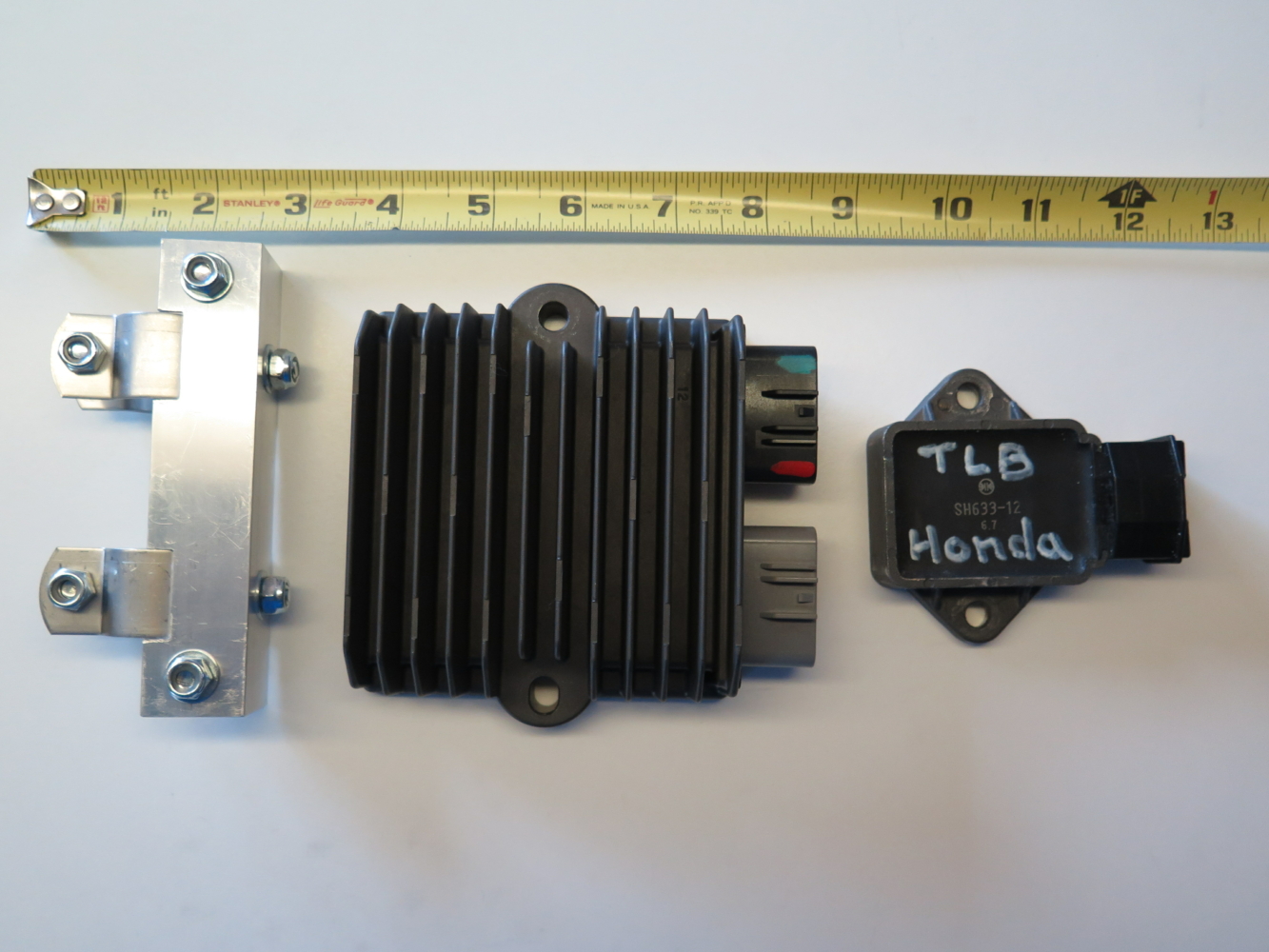
Specifications
Despite considerable hunting, I have not been able to find a comprehensive specification sheet for the SH847 from Shindengen. The following specifications have been cobbled together, but are certainly not guaranteed.
| Property | Value | Note |
|---|---|---|
| Width | 120mm | 100mm between mounting hole centers. |
| Length | 135mm | Plus mating connectors and minimum bending radius for wires. |
| Thickness | 40mm | About 1 9/16″. |
| Current | 30A | Average @ 40°C (104°F) with no airflow. |
| “ | 37A | With 1 m/s (2 1/4 mph) airflow. |
| Peak Current | 50A | PC800 alternator maximum output is 360W or about 30A. |
| Protection | Voltage & Temperature |
Materials
Sources of supply are shown, but feel free to shop around.
- Shindengen SH847 Series R/R kit from RoadsterCycle. Tell Jack you desire the following:
- SH847 Super Kit
- Battery Wire Add On: extra 1 foot (extends DC leads from 36 to 48 inches)
- Stator Wire Add On: 48 inches total (extends AC leads from 12 to 48 inches)
- Request that the battery and stator leads be supplied unterminated.
(The circuit breaker and rings terminals for the battery leads will be supplied with the kit.
You will need to cut the wires to length and terminate them during installation.)
- 1″ x 1″ x 1/16″ aluminum angle 4 3/4″ long.
McMaster-Carr p/n 8982K39, 1 foot long. - 3/4″ pipe hangers, quantity 2.
McMaster-Carr p/n 3006T87. - Various 6.0 x 1.0mm bolts and nuts.
Excess length is not your friend. Nylon-insert lock nuts are a good thing. - Honda stator male connector.
I happened to have one with pigtails sitting on a shelf. Possible sources with no guarantees:
ElectroSport sells a mating pair that looks correct as “ES115 3-pin OLD STYLE Connector Set 1/4″”.
Cycle Terminal sells a mating pair that looks correct as “Set SC250-3”. (Sumitomo Connector, 0.250 inch contact width, 3 poles.) - Braided expandable tubing.
Tidies up the installation and protects the wires from abrasion.
McMaster-Carr p/n 9284K612 (1/4″) will accommodate both the DC (2 conductors) and AC (3 conductors) wires.
255°F rating with good resistance to hydrocarbons and oils. - Adhesive-lined heat shrink tubing.
Prevents the braided expandable tubing from slipping and fraying.
Without the adhesive lining heat shrink can easily slip off the braided tubing.
Mouser Electronics p/n 517-EPS3003/848CLRBK 3M® p/n EPS300-3/8-48″-Clear 3/8″ inch expanded, clear, 3:1 shrink ratio, 230°F rating. - Miscellaneous consumables: tie wraps, DeoxIT® grease, …
Preparation
- Cut the angle stock to length. Do not extend the length beyond that needed to support the R/R from edge to edge.
- Mark and drill the angle stock for the R/R.
- Notch the angle stock for the pipe hangers.
A metal nibbler is a handy tool for notching the stock. The 1/16″ you save will be nice to have later. - Mark and drill the angle stock for the pipe hangers.
Installation
Note that installation of the SH847 leaves the original R/R and wiring in place. You can disconnect the SH847 and reconnect the stock R/R if there is some reason to do so, e.g. the frame is cold.
NB: Do NOT run the engine with both R/Rs connected to the battery at the same time.
You don’t want to find out if the overvoltage protection circuits in the two regulators get into an argument.
I don’t think they will, but with the price of Magic Smoke these days … .
- Remove the right Fairing Protectors (#7), left and right Air Duct/Maintenance Lids (#10) and left and right Side Covers (#11) as explained in Chapter 2 of the Honda PC800 Pacific Coast Service Manual. (Numbers refer to parts on Page 2-2 of the Service Manual. Subsequent pages in Chapter 2 provide details for removal/replacement of the various bits.)
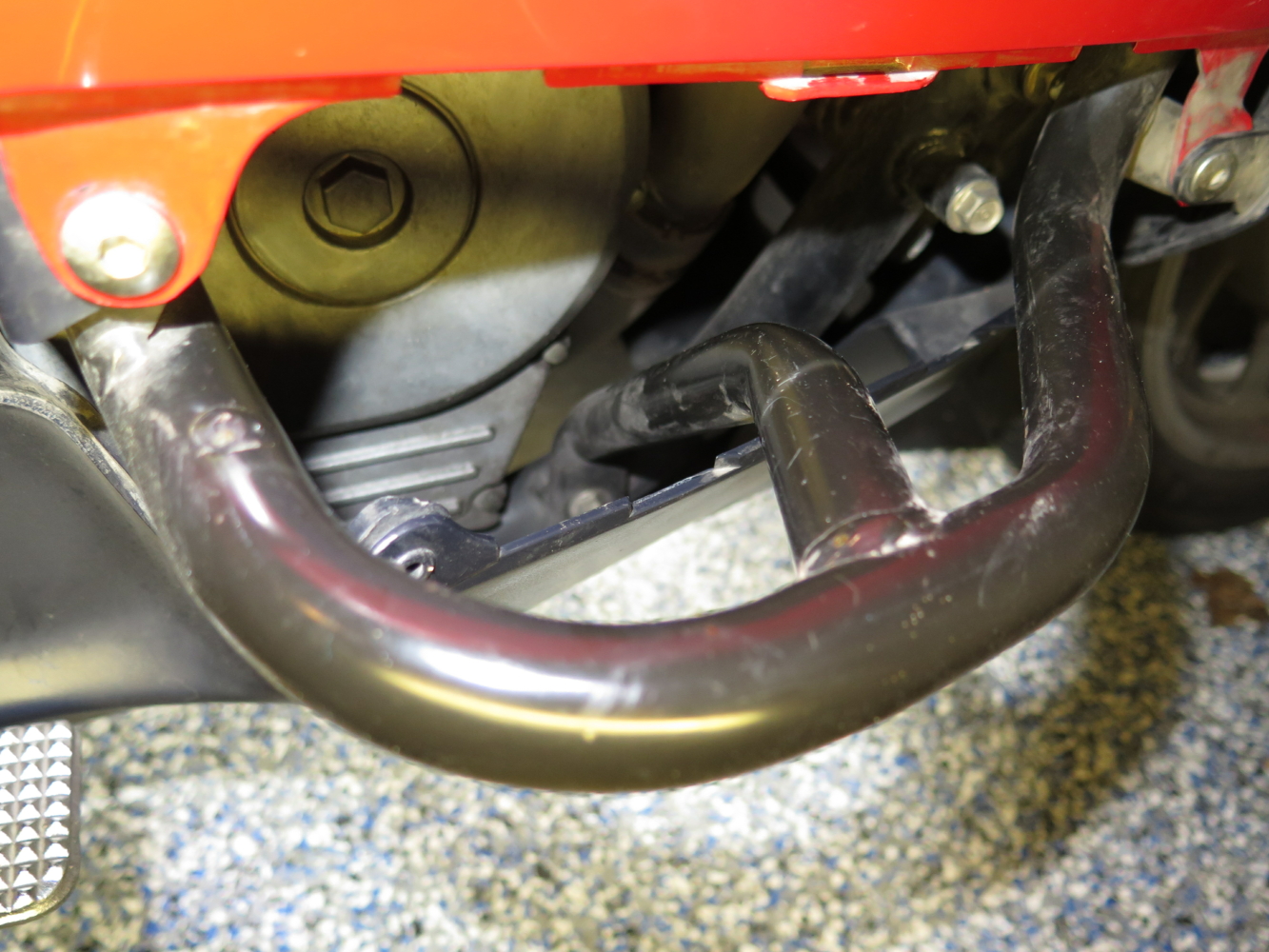
- Mount the SH847 to the angle stock and tighten the bolts.
- Install pipe hangers on angle stock, but do not tighten the bolts.
- Install assembly on engine protector tube and tighten all hardware.
(Okay, you might want to peek at the next step before you tighten down the pipe hanger bolts.)
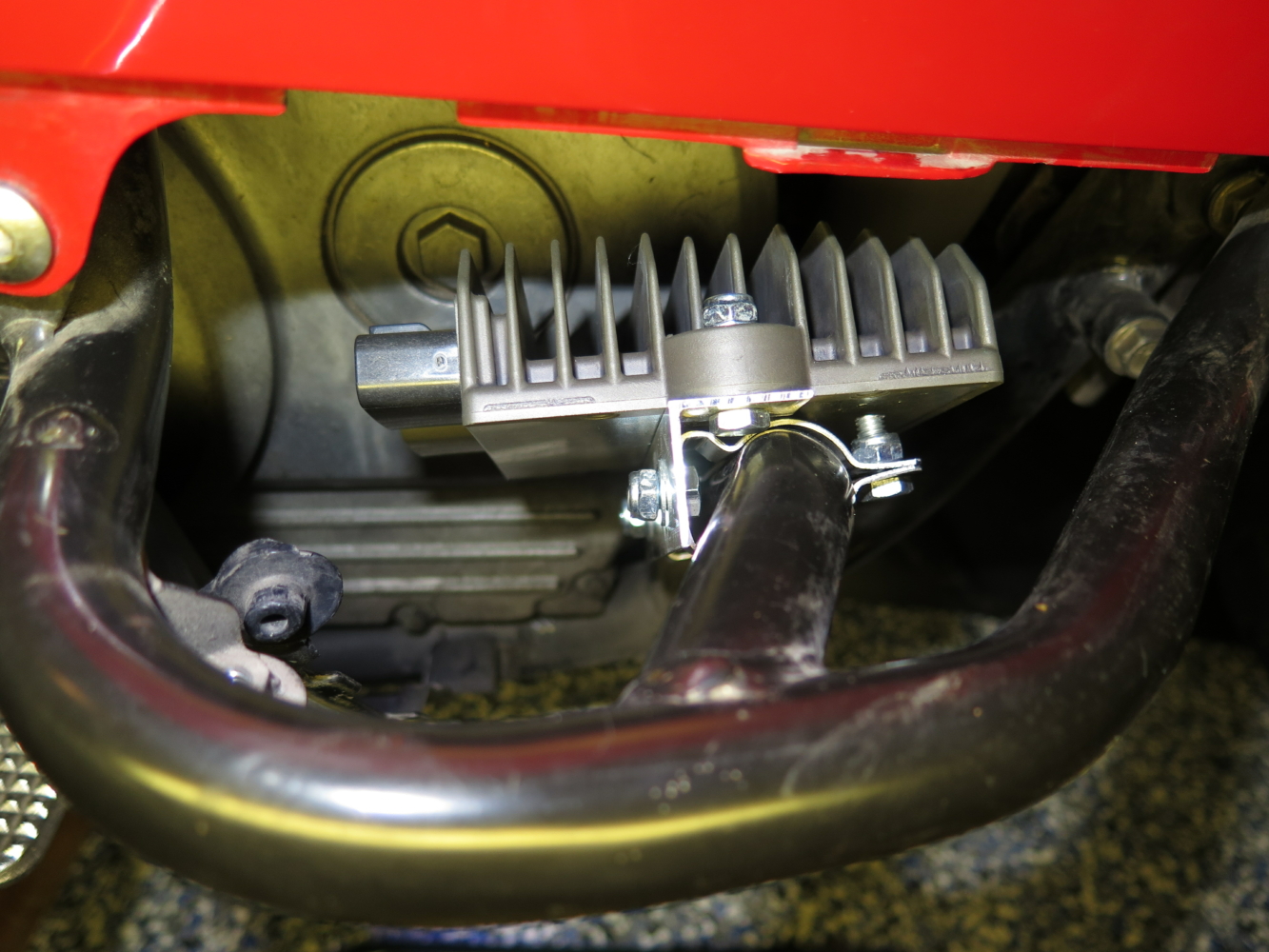
- Check clearance between R/R and crankcase.
Look straight back from the front and confirm that there is clearance between the R/R and crankcase.
Reposition the pipe hangers as needed to maximize the clearance.
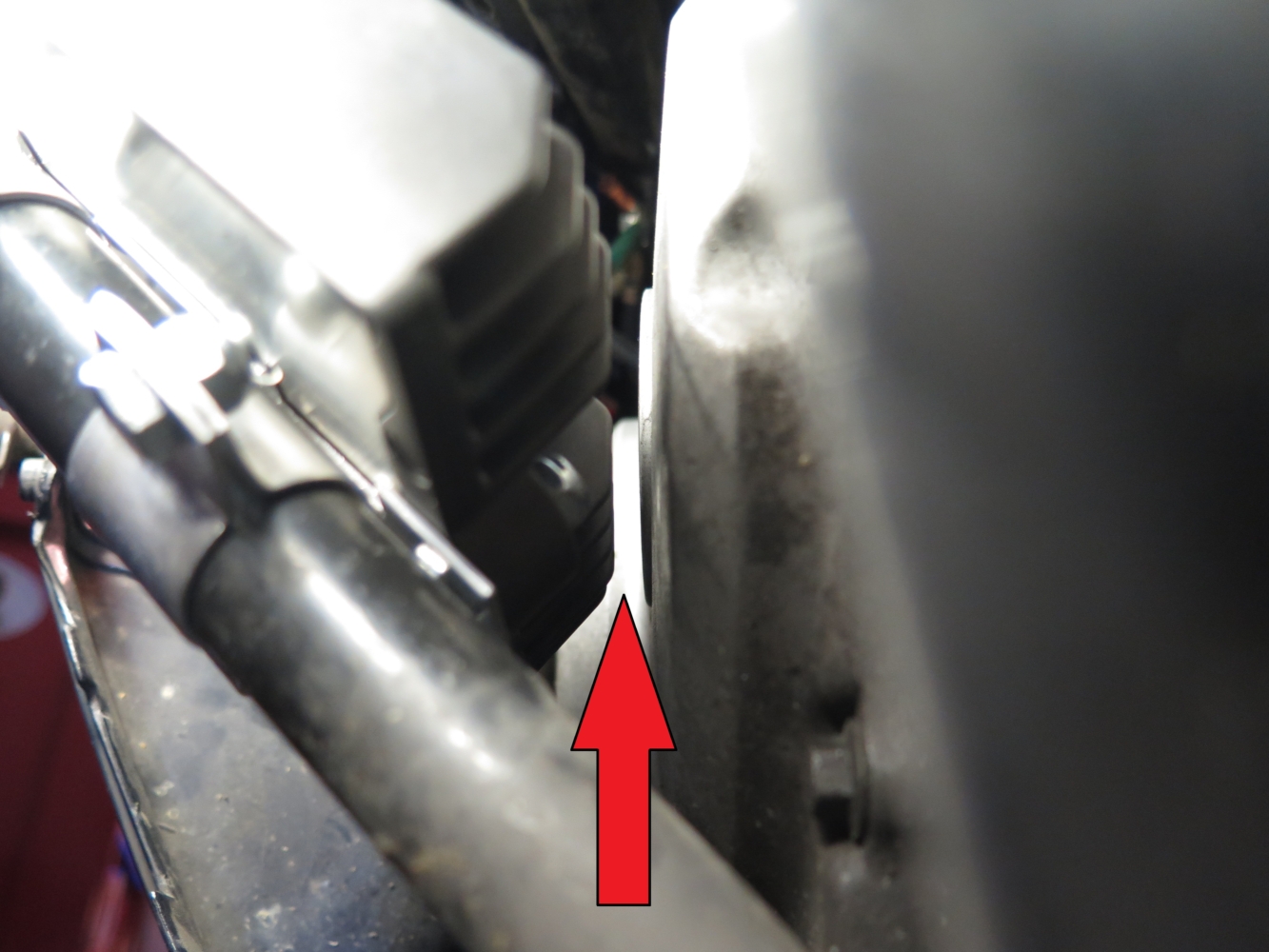
- Unplug the original R/R connector(s), wrap with electrical tape and secure.
(1989 PCs have separate AC and DC connectors at the R/R.) - Unplug the original stator connector, wrap with electrical tape and secure.
- Remove the circuit breaker and jackets from the supplied SH847 wiring harnesses.
The positive conductor (red) has a ring terminal connected to the circuit breaker. - Connect the AC and DC wiring harnesses to the R/R.
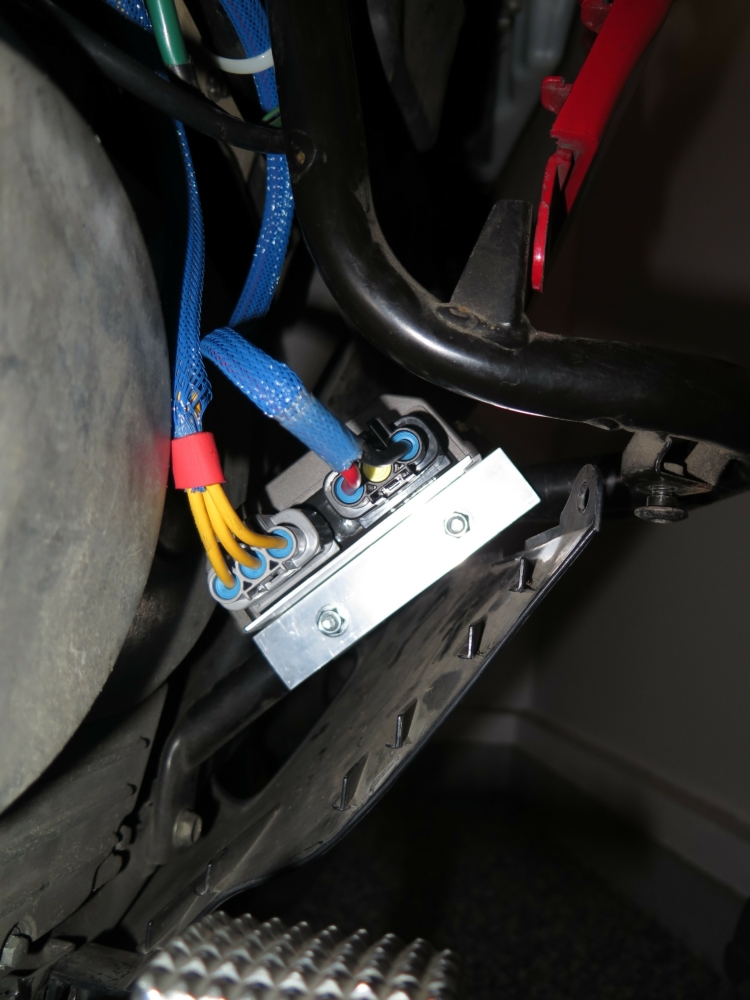
- Route the DC wires (red/black) to the battery and the AC wires (3 yellows) to the stator connector.
Keep in mind that there is limited space between the frame and Tupperware when everything is reassembled.
Cut the wires to length (leaving enough extra length to terminate the wires) and remove the wiring harnesses.
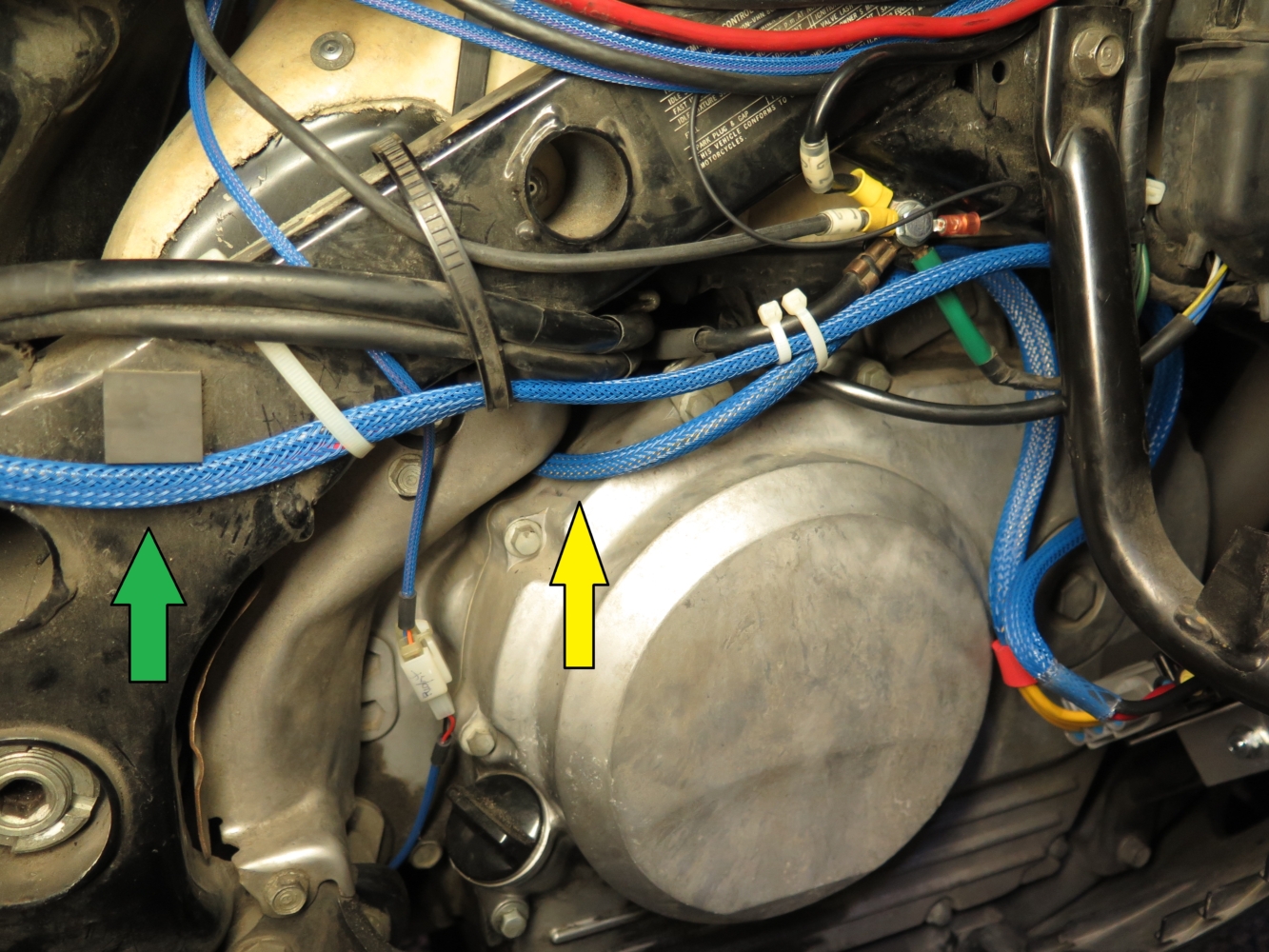
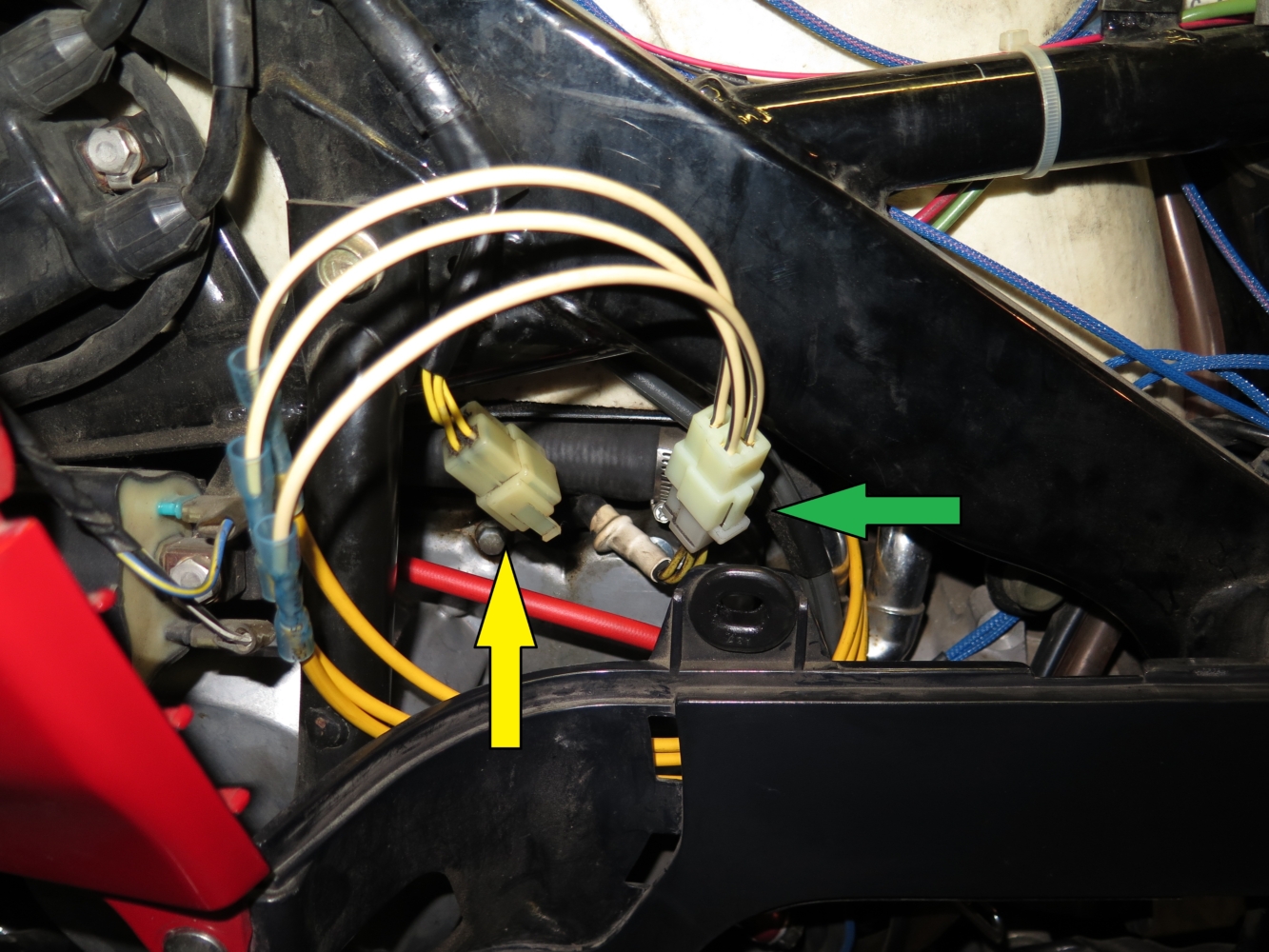
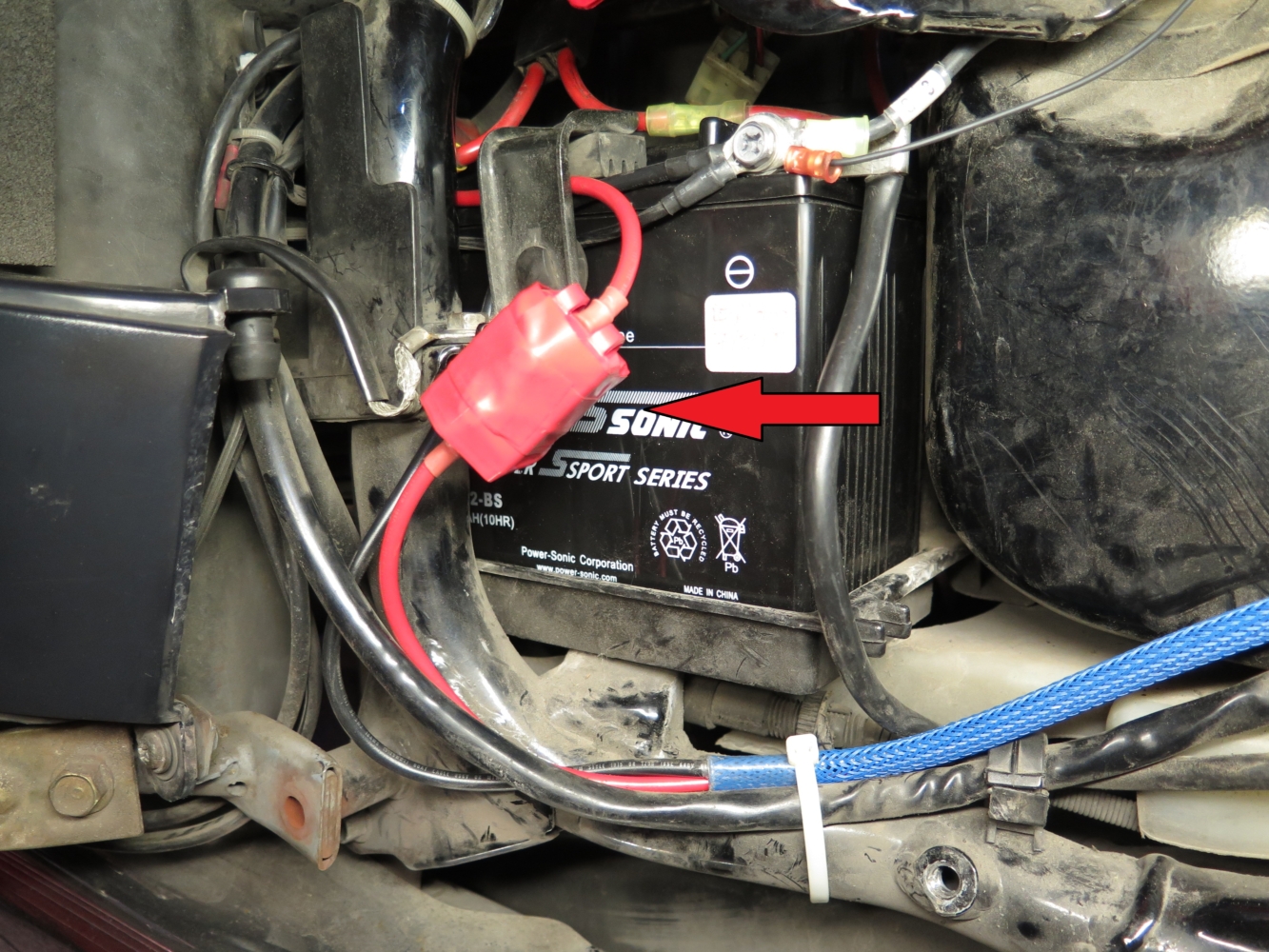
- Add the braided expandable tubing to the wire bundles and heat shrink tubing to the ends of the braided tubing.
Tips:
- Cut two lengths of heat shrink tubing and slip them over the braided tubing before running the wires through the braided tubing.
- The braided tubing gets shorter as it is expanded to fit over the wires. Run the wires through the braided tubing before cutting the tubing to length.
- Depending on the cable routing you may not be able to pass the stator connector through the chosen path, hence the recommendation to terminate the stator cable after adding the braided tubing and reinstalling the cable harness.
- Apply DeoxIT® grease to the R/R contacts and install the AC wiring harness.
Attach the male stator connector to the wiring harness.
Apply DeoxIT® grease to the contacts and mate the stator connectors. - Apply DeoxIT® grease to the R/R contacts and install the DC wiring harness.
Attach the ring terminals to the wiring harness and connect the circuit breaker to the positive (red) conductor. - Connect the positive (red) and negative (black) ring terminals to the battery.
Note: Do NOT reverse the polarity! Momentary contact is all it takes to brick the SH847.
Aside: There is some rational to always connecting the battery ground, negative (black) on a PC, last and removing it first when fiddling with battery connections. With the ground connected you can accidentally short the positive terminal to the frame and other bits and pieces while fiddling about. With the ground disconnected the only place you can short the positive terminal to is the negative terminal.
Testing and Results
Winglet was ridden with various electrical loads. It didn’t matter. The new R/R became lukewarm at most, but never hot. The stock R/R would have removed fingerprints in an instant.
The minimum load was without any accessories and all of the lights replaced with LEDs. With the stock R/R this would result in the maximum amount of current being shunted and thus the maximum heat generated. Aside: At idle with stock lamps and the brake lights on the battery would have been discharging. With LEDs that is not the case.
The following measurements were made with the ignition on and the engine not running. (For perspective, the stock headlight bulb draws 4.9A/5.4A.)
| State | Total Load | Note |
|---|---|---|
| Headlight and running lights. | 1.91A | |
| + Driving lights on high. | 2.84A | Denali D2 LEDs. |
| + Brake lights. | 3.35A |
Maximum load was with a heated vest (about 45W), driving lights, Bushtec trailer and various minor accessories. (All of the trailer lights have been replaced with LEDs with the exception of the license plate lamp. It has wires soldered to the bulb and the bulb is glued in place!) Engine temperature was allowed to rise sufficiently to turn on the cooling fan.
Mann Tracht, Un Gott Lacht
The misfortune that followed provided an opportunity. Not long after installing the new R/R the Rick’s Motorsport Electrics stator installed about 15 years earlier developed a short to ground. (The original stator lasted about 8 years.) An ElectroSport stator was purchased and the experiment was planned. Various resources on the Internet suggested that a shunt regulator reduces the load on the stator when it shorts the windings. (Did you know the word “gullible” isn’t in the dictionary?) It seemed like a good time to get some objective data on stator temperatures under various conditions using shunt and series regulators.
Possibly applicable reading: Facts about shunt-based regulators.
Possibly applicable viewing: “Turbo Encabulator” the Original.
Instrumentation
First, do no harm. I know that the stator is an unhealthy place with hot engine oil, hotter windings and machinery with a low tolerance for loose bits bobbing around. All of the materials going into that environment had to tolerate chemicals and heat. As a SWAG I chose 200°C (392°F) as a target temperature limit. The materials I obtained I dubbed close enough:
- RTD: 1112°F, glass coated platinum element. “Capable of withstanding extreme environmental conditions.”
- Conformal coating: Constant service temperature 320°F.
- Wire: 28 AWG, PTFE insulation, 392°F.
- Heat shrink tubing: PTFE, 500°F operating, 620°F shrinking.
- RTV: Silicone, neutral cure, non-corrosive, 399°F.
Did you catch it? I didn’t. I soldered the wires to the RTD with an 800°F tip in the soldering station. Applied the conformal coating and allowed it to cure. Put the heat shrink tubing on and cranked up the Milwaukee hair dryer to shrink it … . Shrink temperature 620°F. 60/40 Sn-Pb solder melts at 370°F. D’oh! A little creative rearranging and I managed to get the solder to do its thing while the tubing shrank. (“Hats back on gentlemen, an idiot!”)
Aside: While taking soldering/brazing/welding classes I caused some confusion when I used the Milwaukee variable temperature heat gun to sweat solder 3/4″ copper pipe and fittings together.
A Littelfuse PPG102A6 Resistance Temperature Detector (RTD) was embedded between poles of the stator prior to installation. A Fluke 87 Multimeter was used in Min/Max/Avg record mode to capture the temperatures.
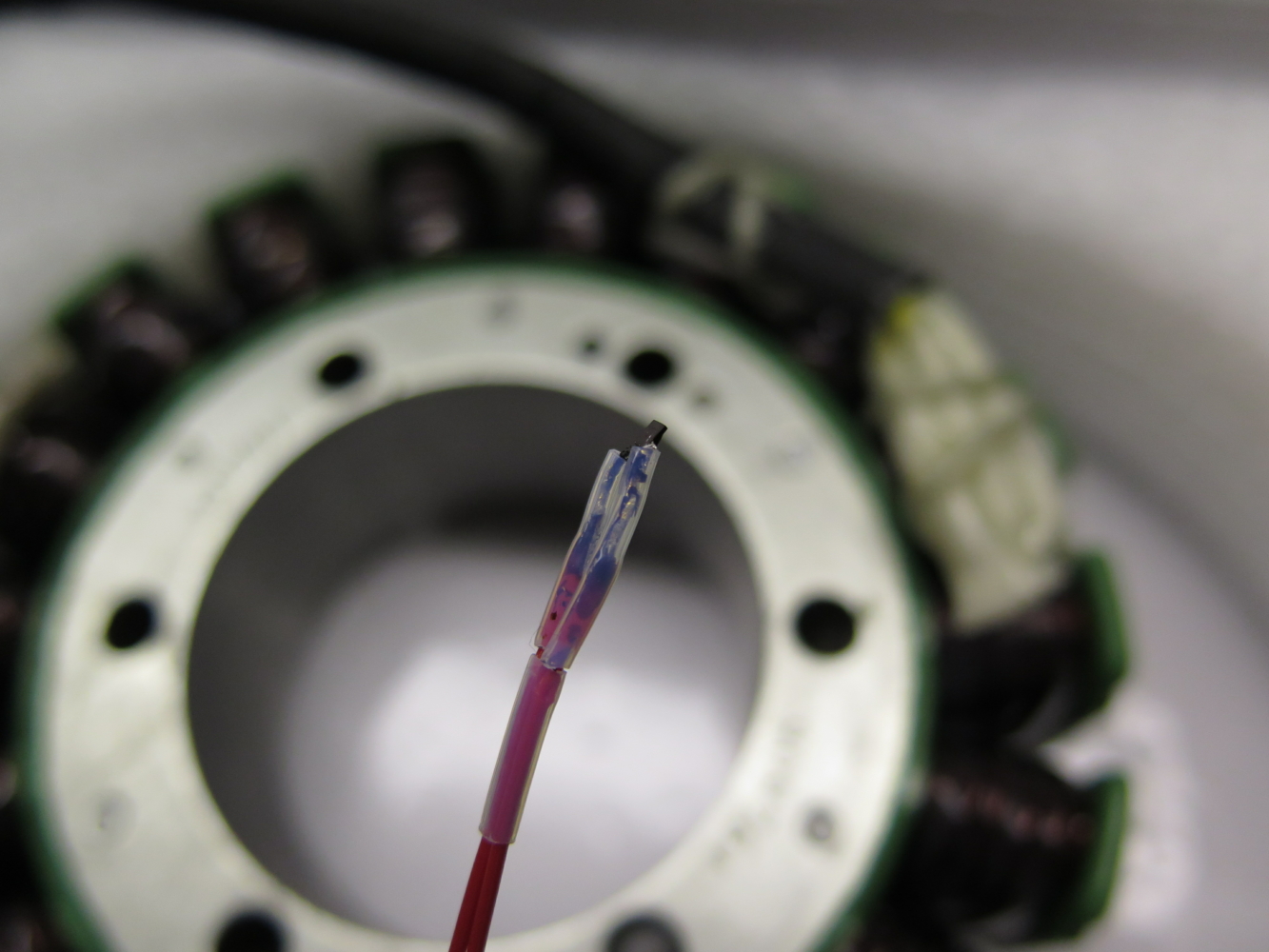
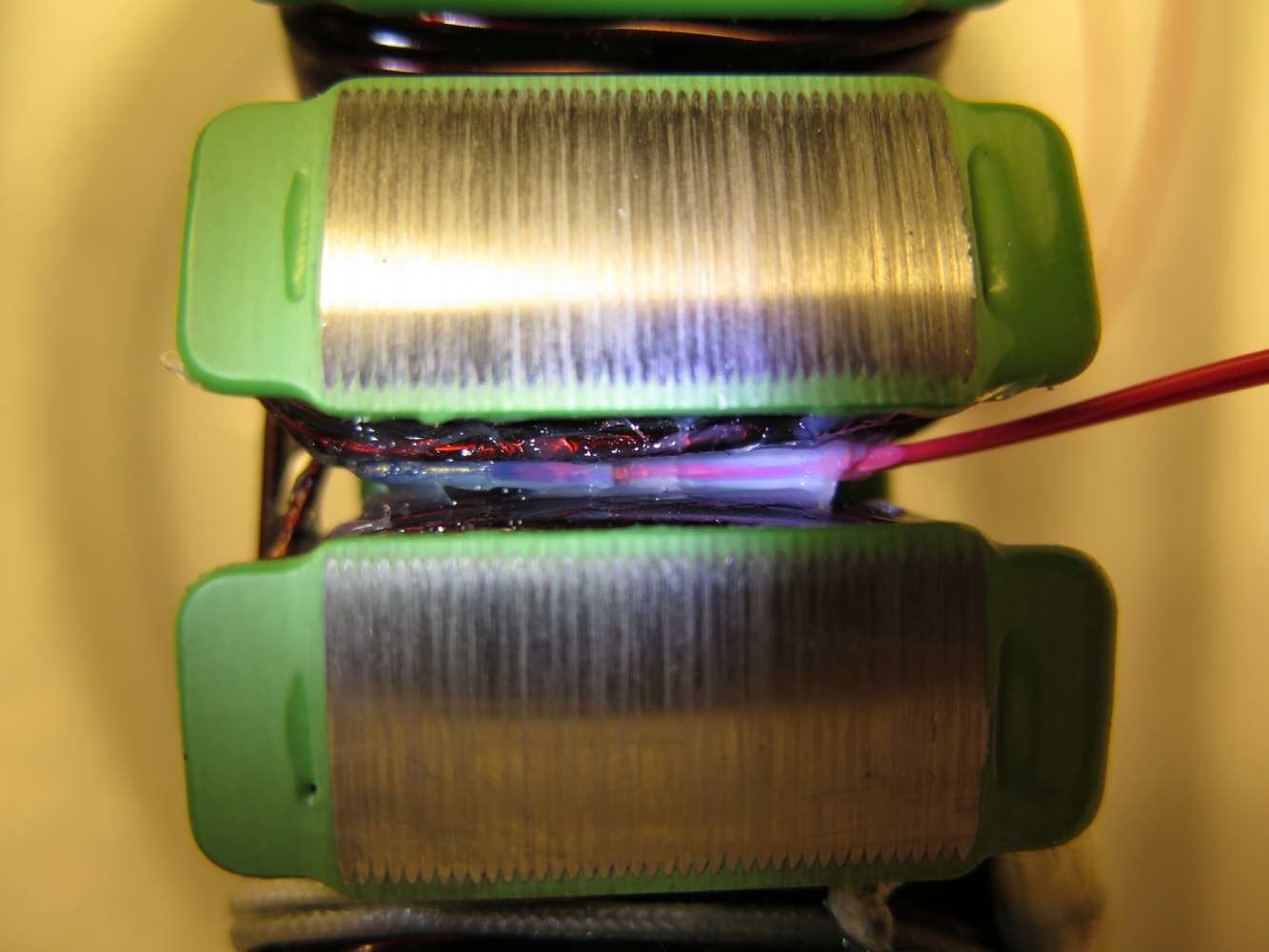
The wires were slipped through the jacket that protects the stator wires. Rather than make changes to the crankcase cover or seals I simply ran the wires out between the cover gasket and the cable seals. A generous dab of Permatex® Ultra Black® gasket maker is working nicely.
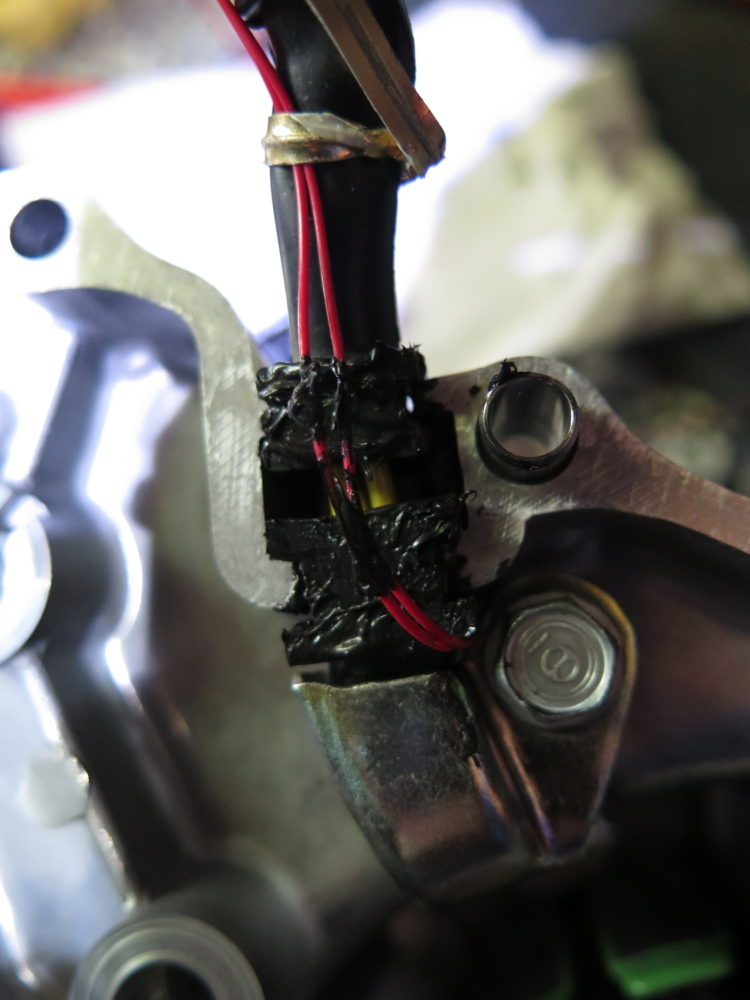
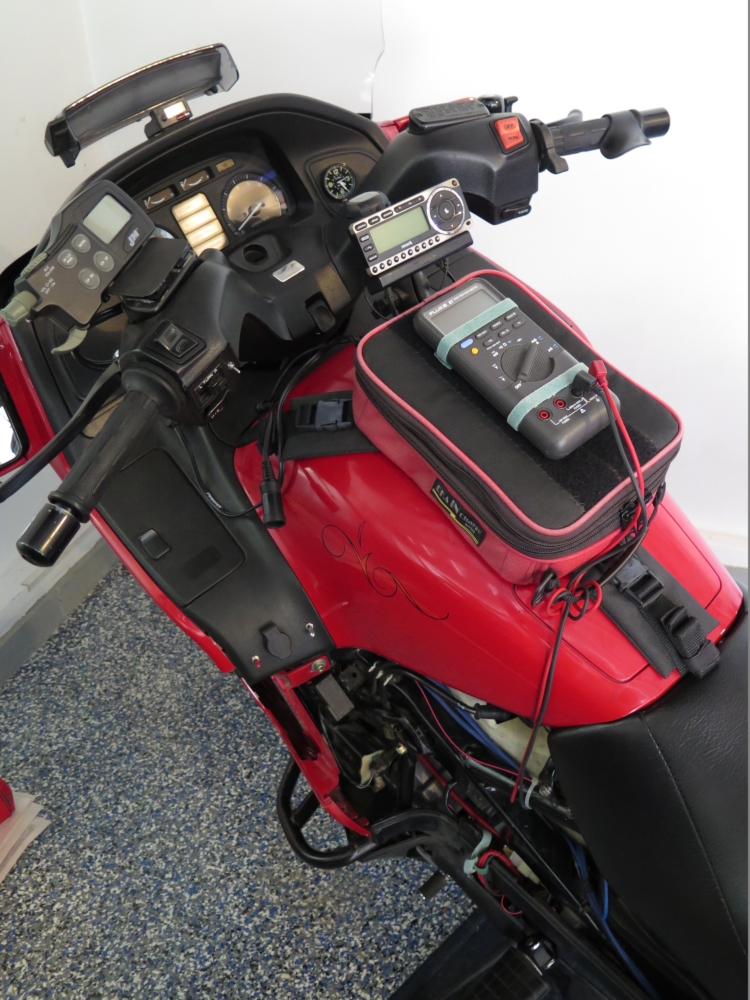
Shunt vs. Series Regulator Test Results
At idle the series regulator supplied <= 3.75A.
Started the engine and allowed it to idle until the fan cycled on and off. 72.6°F ambient temprature, 71°F stator before starting.
- The first test was run on battery only to establish a base temperature for the crankcase.
The battery was recharged after the first test. - The second test was run with the shunt regulator to give it the benefit of a cooler initial temperature.
- The third test was run with the series regulator.
| No Regulator | Shunt Regulator | Series Regulator | Delta (Shunt – Series) | |
|---|---|---|---|---|
| Fan start: | 136°F | 198°F | 170°F | -28°F |
| Fan stop: | 139°F | 200°F | 171°F | -29°F |
| Maximum: | 140°F | 203°F | 173°F | -30°F |
The engine was then run at higher speed (~3K) and the maximum temperature noted:
| Shunt Regulator | Series Regulator | Delta (Shunt – Series) |
|---|---|---|
| 228°F | 212°F | -16°F |
Additional tests were run during sustained operation at highway speed.
- 63°F ambient temperature, the fan did not operate.
- The battery was fully charged prior to starting and recharged during several miles of riding.
- Data collection was started after riding several miles at highway speed.
- A Fluke 87 DMM captured maximum, minimum and average values at 100ms sample time.
- The sampling was stopped prior to exiting the highway and the recorded data was saved while safely parked.
The first test was run with the shunt regulator to give it the benefit of a cooler initial temperature. The second test was run with the series regulator.
| Shunt Regulator | Series Regulator | Delta (Shunt – Series) | |
|---|---|---|---|
| Maximum: | 288°F | 253°F | -35°F |
| Minimum: | 251°F | 240°F | -11°F |
| Average: | 272°F | 248°F | -24°F |
Conclusion: The series regulator lowers the stator temperature under all of the test conditions.

I know the series type runs the stator cooler, but what about the regulator itself? I am more concerned with a cooler running regulator as I am relocating it to a place that gets less airflow and is hotter.
Hi Ben,
That’s a good question and I’m not sure! But Seth might know the answer. He hangs out on https://groups.io/g/ipcrc/
Where are you looking to relocate the R/R?
Cheers,
Douglas in Monterey
I have learned that the series regulators get hotter (but maybe not by much) as they do not use MOSFET yet. I am relocating to behind the left side panel. Hopefully this will not be an issue as far as cooling goes.
Excellent. Working on old 1995 Virago xv1100 I got intrigued about motorcycle electrical systems and the many issues had by owners. Installing LEDs sent r/r into ribeye sear range and yes current saved became current burned. Here someone smarter (you) justifies (difference in wife’s eyes versus mine) purchase of expensive Shindengen R and R plus Electrosport stator. Going out to install and what toys I can add. Thanks, Mike